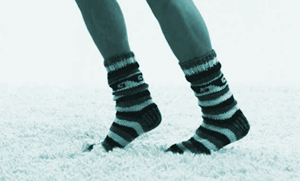GCSE Questions: Static Electricity
Q7.
(a) The photo shows a student walking on a carpet.

The student becomes negatively charged because of the friction between his socks and the carpet. Explain why the friction causes the student to become charged.
Electrons  move from the carpet to the student.
move from the carpet to the student. 
[2 marks]
(b) The student's head is represented by the sphere in the diagram below.


The student is negatively charged. The arrow shows part of the electric field around the student's head. Draw three more arrows on the diagram to complete the electric field pattern.
[1 mark]
(c) The negatively charged student touches a metal tap and receives an electric shock. Explain why.
There is a potential difference  between the student and the tap. The excess electrons on his body travel from his body, through the tap
between the student and the tap. The excess electrons on his body travel from his body, through the tap to earth, down the route of low restistance.
to earth, down the route of low restistance. 
[3 marks]
(d) Some carpets have thin copper wires running through them. The student is less likely to receive an electric shock after walking on this type of carpet. Suggest why.
Copper is a good conductor of electricity, whereas most carpet materials are insulators. Incorporating copper wires in the carpet change it from being an electric insulator to being an electrical conductor.  Charge will therefore not build up on the student, but continually flow to earth.
Charge will therefore not build up on the student, but continually flow to earth.
[2 marks]
[Total 8 marks]


